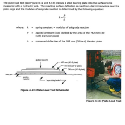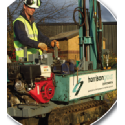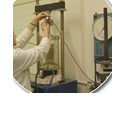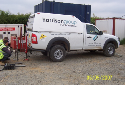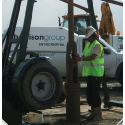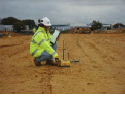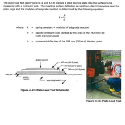Harrison Group Environmental Ltd.
Harrison Group Environmental Ltd is a Geotechnical Engineering Company and provides: Consultancy, ground investigation and contracting services in geotechnical, environmental and natural resources management, pollution control and environmental planning. In addition, our laboratory specialises in soils and materials testing, to include in-situ site testing to BS 1377 as a UKAS certified testing and calibration laboratory to IEN/ISO IEC 17025:2005. All our UK operations are certified under our UKAS accredited BS EN ISO 9001:2008 Quality Management and BS EN ISO 14001:2004 Environmental Management Systems. We operate to OHSAS 18001:2007 and have been externally assessed by CHAS for Health & Safety.
In recent years we have completed a raft of different tasks in East Anglia, including Norfolk, Suffolk, Essex, Lincs, Cambs, and London. We have also worked in the home-counties, midlands, mainland Europe, Middle East and beyond.
Typical work has included: Contaminated Land and Geotechnical Assessment, Flood Risk Assessments, Environmental Impact Assessments, Environmental Resources Surveys, Pollution, Prevention & Control (PPC) Applications, Windfarm EIAs, Subsidence investigations, Due Diligence Audits.
We employ standard investigation mechanisms including: Machine Excavated Trial Pits, Cable Percussive Drilling, Window Sampling, Dynamic Penetration Testing, CBRs, Nuclear Density Gauge Testing, Groundwater and Gas Monitoring, Ground Gas Screening, Gas Vapour Probing, Gas Spike Survey. A suitable report for clients is compiled, whether it is a factual, interpretive and or contamination, depending on the clients specification using standard BS 5930 and Eurocode 7 guidelines.
Window Sampling Dynamic Rig Drilling
Window Sampling is a site investigation tool that utilises portable equipment to drill small diameter boreholes in order to take soil samples and install monitoring wells.
The equipment is portable. Essentially it is a percussion hammer that is used to drive hollow steel tubes into the ground to take representative samples. The hammer can be either hand held, wheel or track mounted.
The specialist sampler tubes are made of steel with side windows cut into them and are in either 1m or 2m lengths. Diameters range from 80mm down to 40mm.
The window sampler can be used to obtain continuous soil samples down to 5m below ground level or deeper, if conditions are suitable. Undisturbed U38 samples can be taken where practicable. If it is required that the sample should be isolated, then an internal liner system can be used for this purpose.
The tubes are removed from the ground either by hydraulic or manual jack.
The sample taken can be easily logged by reviewing through the side window. Simple field tests can be carried out and representative samples taken for future analysis.
The site crew will make initial observations of the samples and record them. This will be followed by logging of samples in the laboratory.
Two man crew + van
Portable, wheel or track mounted percussion hammer
Window sampler tubes, liners and general equipment
Ideal for restricted access sites
Suitable for contamination sampling
No residual spoil
Useful initial intrusive investigative tool
Can be used to install monitoring wells
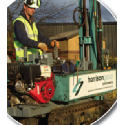
Laboratory Testing
Harrison Group Environmental Limited runs an in-house soils and materials testing laboratory which offers a comprehensive range of geotechnical and materials testing services. It is operated through our Testing Services division.
The laboratory is based in Norwich and has recently undergone expansion. This has enabled us to increase the programme of testing services that are offered to our clients. In addition to this the laboratory holds UKAS accreditation, which has been in place since 2007.
The range of services includes: -
• Classification tests
• Compaction test
• Strength tests
• Root identification
• Materials Testing
• Site quality control testing
The laboratory test equipment utilises the latest technology and is calibrated in accordance with the requirements of the relevant standards. Electronic data logging in conjunction with computerised analysis are an important part of the service that is offered in order to optimise accuracy. As a result of it’s operation through the Harrison Group, clients’ needs are made a priority and turnaround times for testing and issuing results are kept to a minimum.
A full range of chemical testing is also offered to clients including : -
• Metals - including trace metals
• TPH, PCB, PAH, pesticides and volatiles
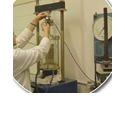
California Bearing Ratio CBRs
CBR is a penetration test for evaluation of the mechanical strength of road subgrades. It consists of causing a plunger of standard area to penetrate a soil sample in order to determine the resistance to deformation under load. As the load is
increased, regular readings are taken of load applied against penetration of the plunger.
The results give the CBR value for the soil and allow the road pavement to be designed. Considerable cost savings can be made if the results are high.
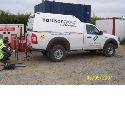
Cable Percussive Drilling
Cable Percussive (CP) Drilling is one of the most traditional and common forms of drilling in the UK.
It is a very versatile method for drilling boreholes in superficial deposits - clays, sands and gravels and is also used for drilling in landfill material.
The advancement of the borehole is achieved by sinking the drilling tools into the borehole, removing material and forming a borehole. The technique is used as both a geotechnical and geoenvironmental tool where soil samples taken can be tested for both physical and chemical properties in our laboratory.
SITE SET UP
• 2 man crew - driller and 2nd man
• 4 x 4 vehicle to tow the drilling rig and carry all drilling tools
CAPABILITY
Boreholes up to 50m depth
Installation of monitoring wells up to 150mm diameter
In - situ testing including : -
• Standard Penetration Testing (SPT)
• Down hole vane testing
• Permeability testing
Disturbed, undisturbed, bulk and water samples can be taken.
Access to restricted areas by using a cut down drilling rig.
Drilling diameters of 150mm, 200mm or 250mm
The driller will draw up a site log of the borehole. This is used as a guide only. From this and further logging of soil samples in the laboratory, a borehole record is drawn up by a Geotechnical Engineer. This forms part of the final interpretative report for the site.
Harrison Group uses cable percussive drillers who are self-employed and contractually bound under agreement to ensure immediate availability and drilling work of a very high standard.
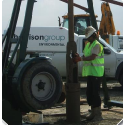
Nuclear Density Testing NDG
Nuclear Density Testing (NDG)
This test is used to establish the:
• wet density
• dry density
• moisture content of soils and granular construction materials.
Measurement of soil density in situ is most commonly used to assess whether material used as backfill, lining or capping (road and landfill construction for instance) has been adequately compacted.
The site operation is very straightforward,
non-destructive with results immediately
available, meaning minimal downtime for the contractor.
As this method makes use of low level radiation, site personnel are fully trained and procedures strictly adhered to.
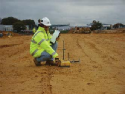
Dynamic Penetration Testing
Dynamic Penetration Testing is a site investigation tool that provides rapid information regarding the relative stiffness and density of superficial deposits.
Depending on the nature of sub soils, probing can be carried out to depths of up to 20m below ground level. In suitable conditions, up to 100m of probing can be achieved in one day.
The dynamic probe rig is used to drive interconnecting 1m length steel probe rods into the ground at the required location. A standard disposable tip is attached to the probe rods, which remains in the ground when the rods are removed.
A 50kg hammer falls repeatedly through a standard drop of 500mm. The rods are graduated at 100mm intervals and blow counts are recorded for each of these increments down to the required depth.
SITE SET UP
Two man crew + van
Portable, wheel or track mounted percussion hammer
Interchangeable, graduated probing rods
Hand operated or hydraulic jack
Ideal for restricted access - can fit through a standard doorway
Easily locates and examines the extent of sub surface soft spots and voids
Can be related to SPT values
No residual spoil
Plate Bearing Tests
Plate Bearing Testing (PBT)
The Plate Bearing Test is most commonly used to measure the short-term settlement of road subgrade or building (or crane) footings under their proposed design load. It consists of a steel plate of known diameter placed on the ground and a load applied by means of a jacking system. A 360 excavator or similar item of heavy plant is used to provide the load to jack up against.
Each test might last for a few hours and this method is an economical way to establish useful soil characteristics.
Results are plotted as settlement against load and the following soil parameters can be calculated:
• Modulus of subgrade reaction
• Permanent deformation characteristics
• Shear strength of the soil
The results are checked against the design load settlement criteria for the future land use, and it is possible to make savings in foundation design if the values are consistently high.
On site the set -up is very similar to that of the CBR test. A jack and load cell are used in place of the CBR equipment and heavier plant is required to jack up against.
